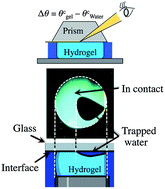In situ observation of a hydrogel–glass interface during sliding friction
Abstract
Direct observation of hydrogel contact with a solid surface in water is indispensable for understanding the friction, lubrication, and adhesion of hydrogels under water. However, this is a difficult task since the refractive index of hydrogels is very close to that of water. In this paper, we present a novel method to in situ observe the macroscopic contact of hydrogels with a solid surface based on the principle of critical refraction. This method was applied to investigate the sliding friction of a polyacrylamide (PAAm) hydrogel with glass by using a strain-controlled parallel-plate rheometer. The study revealed that when the compressive pressure is not very high, the hydrogel forms a heterogeneous contact with the glass, and a macro-scale water drop is trapped at the soft interface. The pre-trapped water spreads over the interface to decrease the contact area with the increase in sliding velocity, which dramatically reduces the friction of the hydrogel. The study also revealed that this heterogeneous contact is the reason for the poor reproducibility of hydrogel friction that has been often observed in previous studies. Under the condition of homogeneous full contact, the molecular origin of hydrogel friction in water is discussed. This study highlights the importance of direct interfacial observation to reveal the friction mechanism of hydrogels.


 Please wait while we load your content...
Please wait while we load your content...